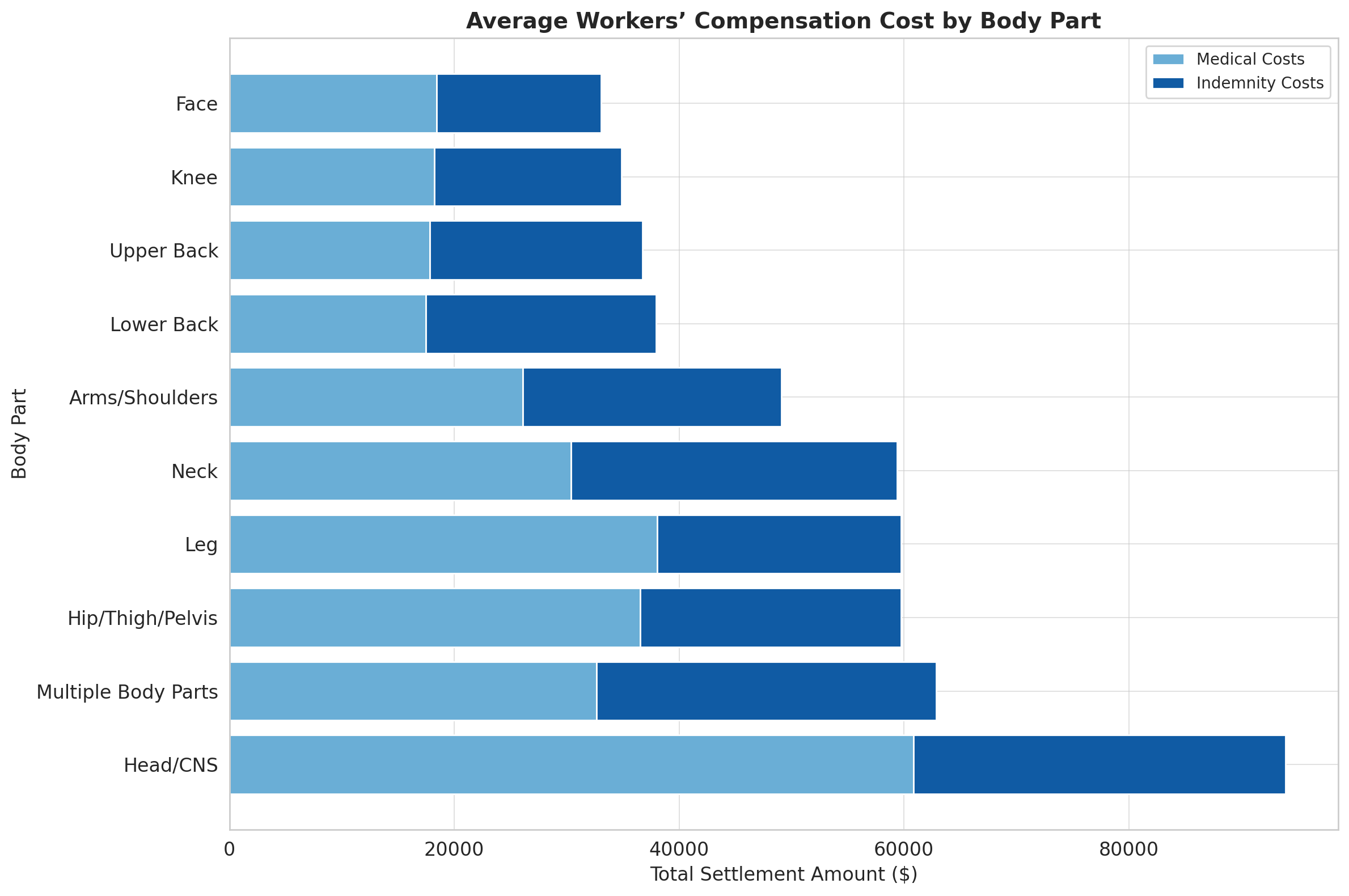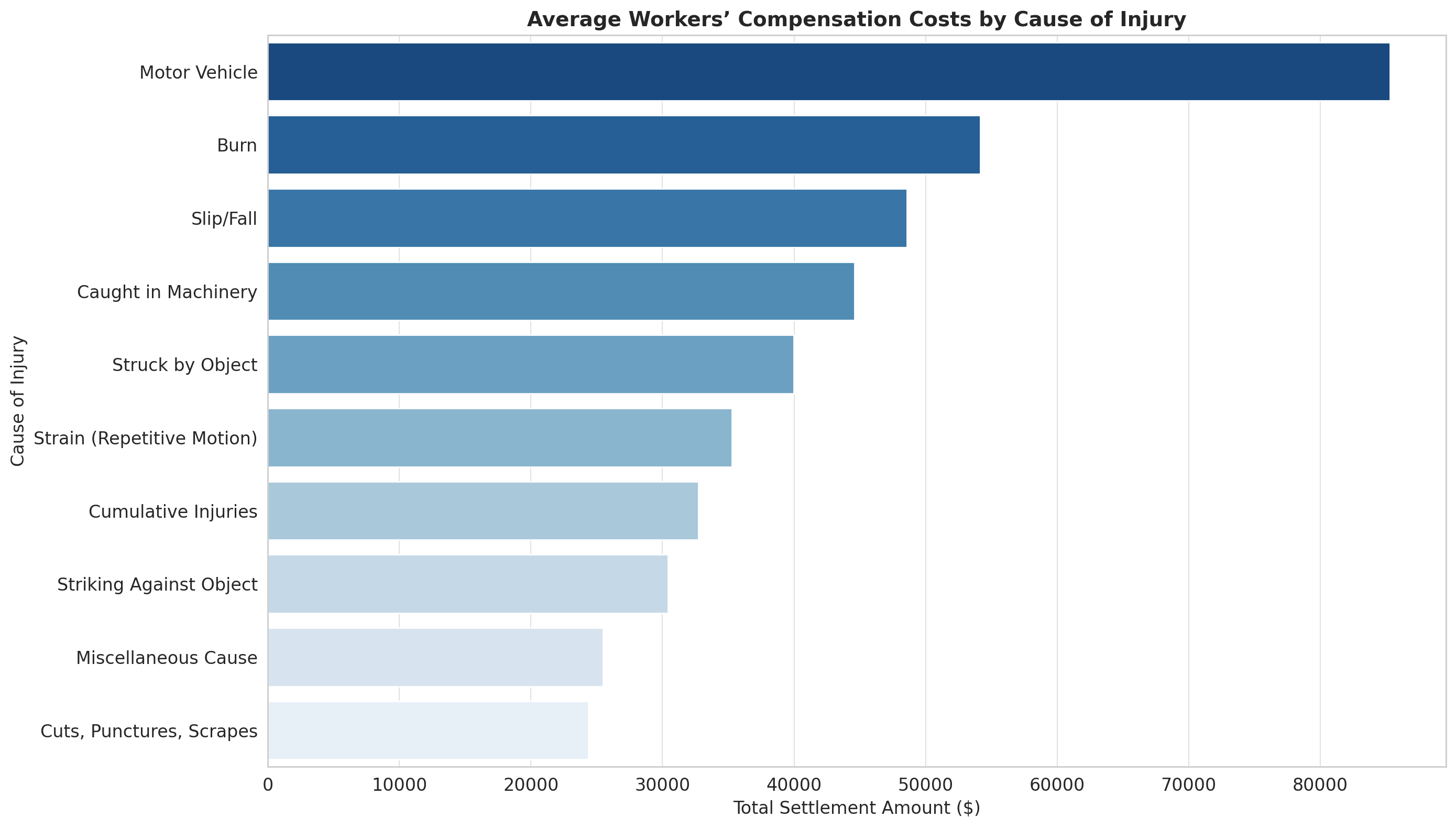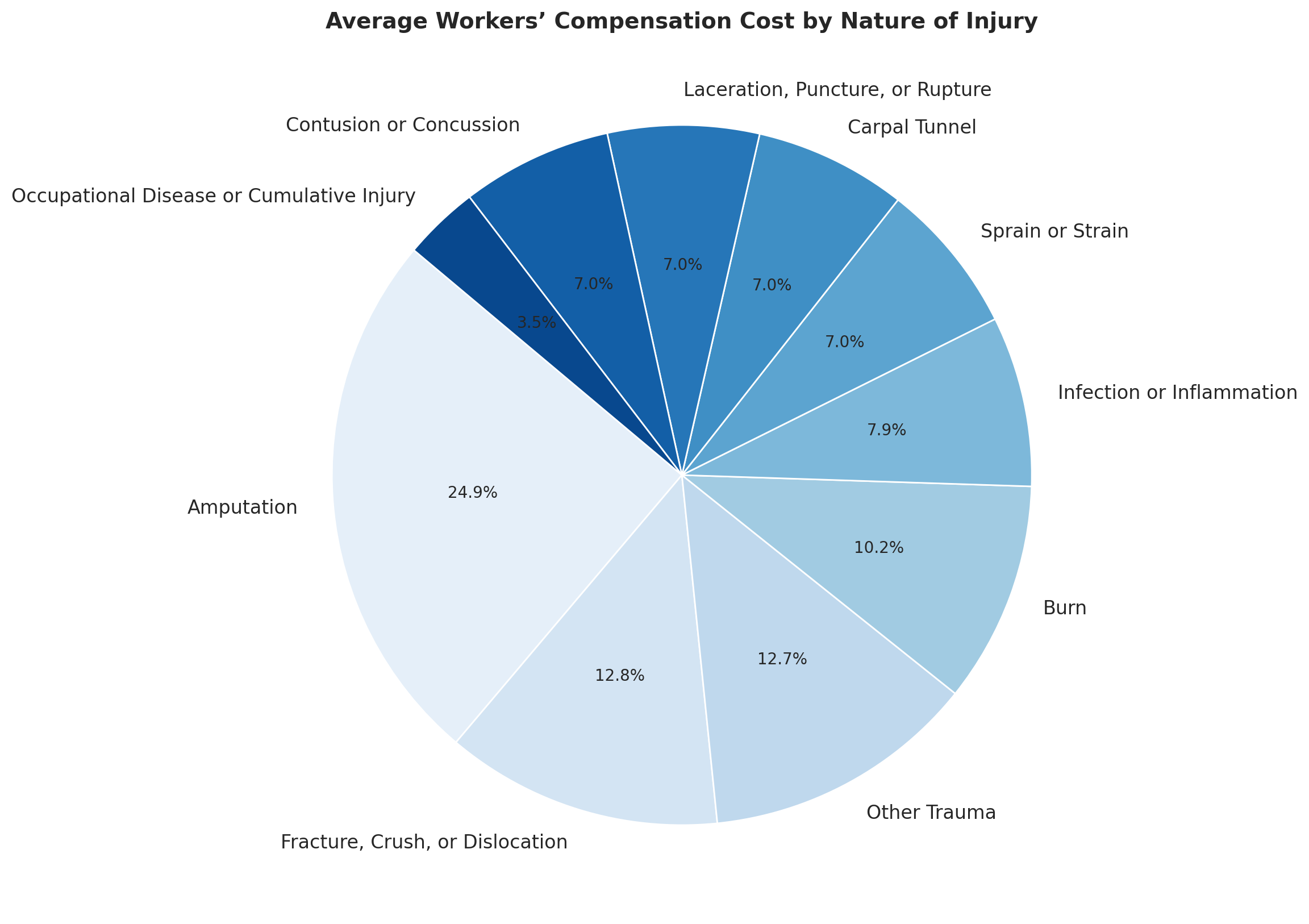How Much Are California Workers’ Compensation Settlements?
If you’re considering filing a workers’ compensation claim, you may be wondering: How much are California workers’ comp settlements?
In California, workers’ compensation settlements typically range from $2,000 to $40,000, depending on the severity of the injury, lost wages, and medical expenses. According to Martindale Nolo research, the average workers’ comp settlement nationwide is $21,800. Severe injuries may result in significantly higher payouts.
Having helped countless injured workers secure fair settlements, I understand the factors that influence compensation. Below, we’ll explore the types of workers’ comp settlements, how they are calculated, and what you can do to maximize your claim.
Understanding California Workers’ Comp Settlement Amount Variables
In California, workers’ compensation settlements typically range from $2,000 to $40,000, but can vary widely depending on the circumstances of the injury.
Settlement amounts
- 12% of settlements are less than $2,000
- 55% of settlements are between $2,000 and $20,000
- 13% of settlements are between $20,001 and $40,000
- 12% of settlements are between $40,001 and $60,000
- 8% of settlements are between $60,001 and $100,000
Factors affecting settlement
- The type of injury
- The treatment required, such as surgery or physical therapy
- The resulting disability
- Current and future medical care costs
Disability ratings
- Disability ratings are based on the severity and kinds of disability
- The number of weeks of payments is calculated by multiplying the disability rating by a number
- For example, a disability rating of 10 to 24.75 is multiplied by 5 to calculate the number of weeks of payments
Death benefits
- If an employee dies in a work-related accident, their families are entitled to death benefits
What Are the Average Workers’ Compensation Costs by Body Part?
Understanding how settlement amounts vary based on the affected body part is crucial for injured workers. Some injuries require extensive medical treatment, rehabilitation, and may lead to long-term disabilities, significantly increasing settlement values.
The average workers’ compensation costs vary by body part, with chest injuries averaging $14,500 in medical costs and $13,500 in indemnity. Foot and toe injuries cost around $15,400, while hand and finger injuries average $14,800 in medical expenses. Severe injuries, such as head or spinal injuries, can result in significantly higher payouts.

Generally, injuries affecting the head, neck, and spine result in higher compensation, while minor extremity injuries may have lower payouts. The following table provides a breakdown of average workers’ compensation settlements by body part.
| Body Part | Medical Costs | Indemnity | Total Settlement |
|---|---|---|---|
| Head/CNS | $60,875 | $33,067 | $93,942 |
| Multiple Body Parts | $32,647 | $30,212 | $62,859 |
| Hip/Thigh/Pelvis | $36,553 | $23,205 | $59,758 |
| Leg | $38,049 | $21,699 | $59,748 |
| Neck | $30,404 | $28,987 | $59,391 |
| Arms/Shoulders | $26,088 | $23,028 | $49,116 |
| Lower Back | $17,486 | $20,480 | $37,966 |
| Upper Back | $17,799 | $18,955 | $36,754 |
| Knee | $18,239 | $16,639 | $24,932 |
| Face | $18,435 | $14,646 | $33,081 |
Source: Insurance Business Mag
Does Surgery Increase a Workers Comp Settlement in California?
Yes, surgery typically increases workers’ compensation settlements in California. This is because surgery often indicates a more severe injury, which can lead to: higher medical costs, longer recovery times, more significant physical limitations, and potential permanent disability.
What Are the Average Workers’ Compensation Costs by Cause of Injury?
According to the National Council on Compensation Insurance (NCCI), motor vehicle crashes lead to the most expensive workers’ compensation claims, averaging $90,914 per claim. Burns follow at $67,224, while “other trauma” cases average $64,856. Injuries involving fractures, crushes, or dislocations result in an average cost of $63,531.

The cause of an injury can significantly impact the amount of a workers’ compensation settlement. Some workplace accidents, such as motor vehicle crashes and machinery-related injuries, tend to result in higher medical costs and lost wages, leading to larger settlements. Meanwhile, injuries caused by slips, repetitive motion, or minor cuts often lead to lower compensation amounts. The following table provides a breakdown of average settlements based on the cause of injury.
| Cause of Injury | Medical Costs | Indemnity | Total Settlement |
|---|---|---|---|
| Motor Vehicle | $47,500 | $37,811 | $85,311 |
| Burn | $36,477 | $17,696 | $54,173 |
| Slip/Fall | $27,225 | $21,350 | $48,575 |
| Caught in Machinery | $26,188 | $18,400 | $44,588 |
| Struck by Object | $22,093 | $17,884 | $39,977 |
| Strain (Repetitive Motion) | $17,421 | $17,870 | $35,291 |
| Cumulative Injuries | $15,492 | $17,253 | $32,745 |
| Striking Against Object | $16,107 | $14,310 | $30,417 |
| Miscellaneous Cause | $12,557 | $12,938 | $25,495 |
| Cuts, Punctures, Scrapes | $14,530 | $9,845 | $24,375 |
Source: Insurance Business Mag
What Are the Average Workers’ Compensation Costs by Nature of Injury?
The average workers’ compensation payout varies by injury type. Amputations have the highest average at $126,000, followed by fractures at $63,000, burns at $52,000, and sprains at $34,000. Motor vehicle crashes are the most costly cause, averaging $89,152 per claim. Severity and body part affected impact compensation.

The nature of an injury plays a significant role in determining the settlement amount. Severe injuries, such as amputations and fractures, tend to result in higher compensation due to long recovery periods and potential permanent disabilities. Conversely, less severe injuries, such as sprains or carpal tunnel syndrome, may lead to lower settlements as they typically require less extensive treatment. The table below highlights the average workers’ compensation settlement amounts based on the type of injury.
| Injury Type | Total Settlement |
|---|---|
| Amputation | $118,837 |
| Fracture, Crush, or Dislocation | $60,934 |
| Other Trauma | $60,288 |
| Burn | $48,671 |
| Infection or Inflammation | $37,498 |
| Sprain or Strain | $33,589 |
| Carpal Tunnel | $33,477 |
| Laceration, Puncture, or Rupture | $33,348 |
| Contusion or Concussion | $33,151 |
| Occupational Disease or Cumulative Injury | $16,696 |
Source: National Safety Council (NSC)
Even though these numbers show average settlements, every case is different. If you need an accurate estimate, consult with a qualified workers’ compensation attorney.
California Workers’ Compensation Death Benefits Chart
Losing a loved one due to a work-related injury or illness can be devastating, and workers’ compensation laws in California provide financial support for surviving family members. Death benefits are designed to help cover burial costs and provide financial support to dependents. The amount received depends on the number of dependents and their level of dependency on the deceased worker’s income.
The table below outlines the death benefits available to dependents based on the date of injury and number of dependents.
| Date of Injury | Burial Payment | 1 Dependent | 2 Dependents | 3+ Dependents |
|---|---|---|---|---|
| After Jan. 1, 2013 | $10,000 | $250,000 | $290,000 | $320,000 |
*Partial dependents will receive up to four times the amount of annual support, up to a total of $290,000.
California Temporary Disability in 2025
Temporary disability benefits support workers who temporarily cannot work due to a job-related injury. Payments cover two-thirds of the worker’s average weekly wage, up to a state-set maximum.
California Permanent Disability in 2025
If a worker has 100% permanent disability, they usually receive two-thirds of their average weekly income. If the disability is less than 100%, payments range from $160 to $290 per week.
Get in Touch with a Workers’ Compensation Lawyer
If you’ve been injured at work, don’t risk losing the compensation you deserve. Call Scher, Bassett & Hames today at (408) 739-5300 for a free, no-obligation consultation. Our experienced workers’ compensation attorneys will fight aggressively to maximize your settlement, ensuring you get the medical care, lost wages, and financial support you’re entitled to. The sooner you act, the stronger your case—call now and take the first step toward financial recovery!
Further Reading:
- How to File a Workers’ Compensation Claim in California
- When Can You Sue for a Work-Related Injury in California?
- How Long Does It Take for a Workers Comp Settlement in California?
- What Benefits Can You Get From Workers’ Compensation in California?
- What Should You Know About Workers’ Compensation Claims in California
FAQs About Workers Comp Settlements in California
What Expenses Are Covered by Workers’ Compensation in California?
Medical treatments – Doctor visits, hospital stays, surgeries, and rehabilitation.
Prescription medications – Any necessary medications related to the injury.
Lost wages – Compensation for time missed from work due to the injury.
Permanent disability benefits – If the injury results in long-term impairment.
Vocational retraining – If the employee cannot return to their previous job.
Mileage reimbursement – Coverage for travel expenses to medical appointments.
Understanding these benefits can help injured workers maximize their claim and receive the full compensation they are entitled to.
How Do You File a Workers’ Compensation Claim in California?
Report the injury – Notify your employer within 30 days of the injury.
Complete the DWC-1 form – Your employer should provide you with the official claim form.
Seek medical treatment – See a doctor authorized by your employer’s workers’ compensation insurance.
Submit your claim – Your employer must forward the completed form to the claims administrator.
Follow up – Stay in contact with the claims administrator and attend required medical evaluations.
Consult an attorney – If your claim is delayed or denied, an attorney can help protect your rights.
By following these steps, injured workers can ensure their claim is processed efficiently and without unnecessary delays.
What Happens If an Employer Disputes a Workers’ Compensation Claim?
Gather evidence – Keep detailed records of the injury, witness statements, and medical reports.
File an appeal – If your claim is denied, you can appeal to the California Division of Workers’ Compensation (DWC).
Attend a hearing – A judge will review the evidence and determine whether you qualify for benefits.
Seek legal help – A workers’ compensation attorney can provide legal representation and improve the chances of a successful appeal.
Employees have the right to challenge claim denials and receive the compensation they deserve.
How Long Does a Workers' Compensation Settlement Take?
The severity of the injury and necessary medical treatment.
The complexity of the case, including disputes over liability.
Whether the insurance company offers a fair settlement or requires litigation.
On average, most workers’ compensation settlements in California take between 12 and 24 months, though some cases may resolve in as little as 6 months. If a case requires a hearing or appeal, the process can extend beyond two years.
Do all workers comp cases end in a settlement in California?
Can You Receive Workers’ Compensation Benefits While Still Working?
Their doctor places work restrictions that limit physical tasks.
They earn less than their pre-injury wages due to limited duties.
Their employer provides alternative work but at a lower rate of pay.
Even if you return to work, you may still qualify for compensation, including medical expenses and wage loss benefits.
What Happens If Your Workers’ Comp Claim Is Denied?
Failure to report the injury on time.
Insufficient medical evidence.
Employer disputes over how the injury occurred.
If your claim is denied, you have the right to challenge the decision through the California Workers' Compensation Appeals Board (WCAB). A skilled attorney can help gather medical evidence, represent you at hearings, and fight for your rightful benefits.



